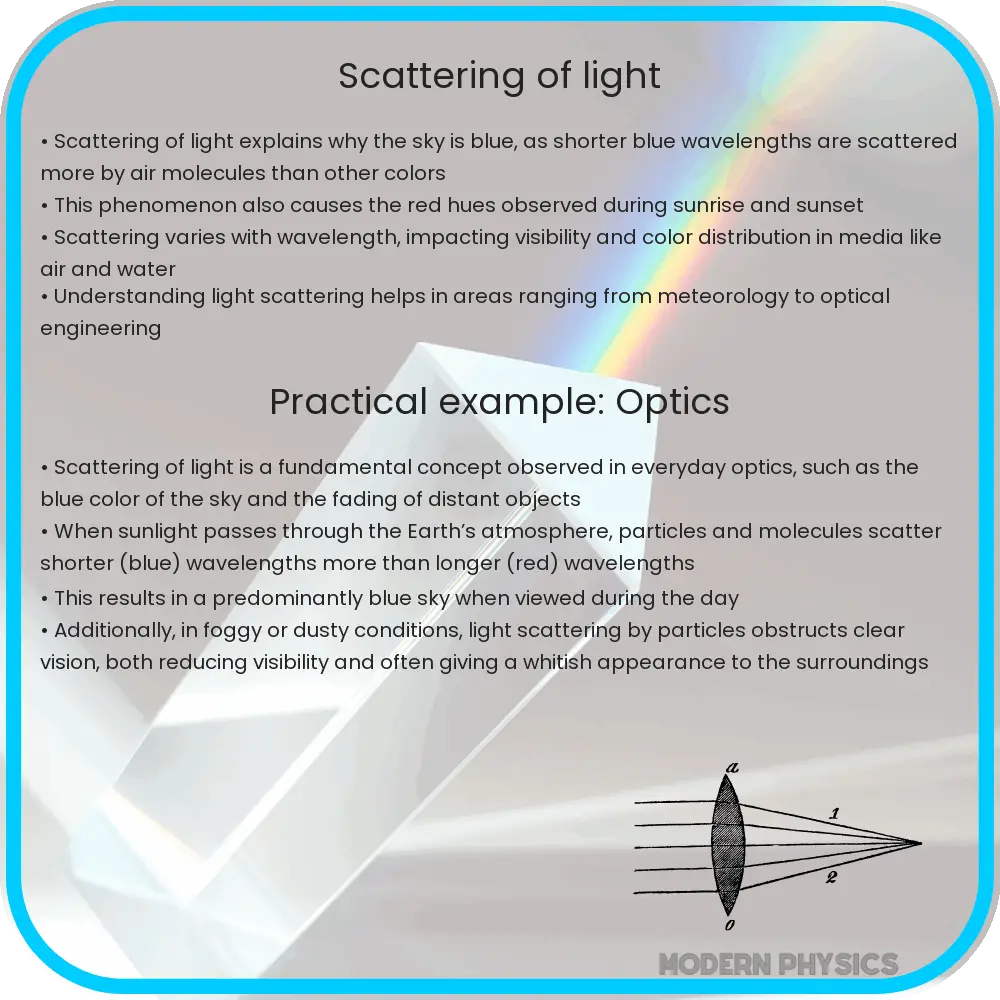Explore the fascinating world of light scattering, its principles from particle interaction to wave theory, and its diverse applications in science and tech.

Understanding the Scattering of Light: Fundamentals and Implications
Light scattering is a fundamental phenomenon that occurs when light waves encounter particles or obstacles, causing the light to be redirected in various directions. This interaction is not only pivotal in understanding the basic principles of optics but also has significant applications across multiple scientific and technological fields. By exploring both the particle interaction and wave theory perspectives, we can gain a comprehensive understanding of light scattering and its implications.
Particle Interaction in Light Scattering
At the core of light scattering through particle interaction is the concept that light, when it encounters particles smaller than its wavelength, undergoes a change in direction. This is often described in terms of Rayleigh scattering, which occurs when the particles are much smaller than the wavelength of the light. The intensity of scattered light in Rayleigh scattering is inversely proportional to the fourth power of the wavelength (I ∝ λ-4), explaining why the sky appears blue: shorter (blue) wavelengths scatter more than longer (red) wavelengths.
Wave Theory Perspective
The wave theory of light provides another perspective on scattering, emphasizing the wave nature of light. According to this theory, light is a form of electromagnetic radiation that propagates as waves. When these waves encounter obstacles or irregularities, such as particles or rough surfaces, they are scattered in different directions. This scattering can be understood through principles such as diffraction and interference, which explain how waves spread out and interact with each other upon encountering an obstacle.
Applications of Light Scattering
Light scattering has diverse applications, from the analysis of atmospheric phenomena to the development of advanced materials. In atmospheric science, understanding light scattering helps explain the color of the sky and the appearance of phenomena such as halos and rainbows. In materials science, scattering techniques like Raman spectroscopy and dynamic light scattering are crucial for characterizing materials at the molecular and nano scales, providing insights into particle size, shape, and distribution.
This exploration of light scattering from both the particle interaction and wave theory perspectives lays the groundwork for understanding its broad implications in science and technology. The subsequent sections will delve deeper into the mathematical foundations, specific types of scattering, and cutting-edge applications in fields ranging from telecommunications to biomedical engineering.
Mathematical Foundations of Light Scattering
The mathematical analysis of light scattering is grounded in the principles of electromagnetic theory and quantum mechanics. Maxwell’s equations, which describe the behavior of electromagnetic fields, are fundamental to predicting how light waves interact with particles. For Rayleigh scattering, the size parameter (the ratio of the circumference of the particle to the wavelength of light) significantly influences the scattering intensity and pattern. In more complex scenarios, such as Mie scattering (applicable to particles with sizes comparable to the wavelength of light), exact solutions to Maxwell’s equations are employed to accurately describe the scattering phenomena.
Specific Types of Light Scattering
Beyond Rayleigh and Mie scattering, there are several other specific types of light scattering that have unique implications in various applications. For instance, Brillouin and Raman scattering involve the interaction of light with phonons in a medium, leading to shifts in the frequency of the scattered light. These shifts provide valuable information about the physical properties of the medium, such as temperature and molecular structure. Another example is Tyndall scattering, observed in colloidal suspensions, where the scattered light is due to particles larger than the wavelength of light, resulting in a blue hue in the scattered light similar to Rayleigh scattering but for different reasons.
Technological and Scientific Applications
The principles of light scattering are harnessed in numerous technological and scientific applications. In telecommunications, optical fibers utilize controlled scattering and total internal reflection to efficiently transmit light signals over long distances. Environmental monitoring benefits from light scattering to detect and analyze pollutants, while in medicine, techniques like laser scattering are used in diagnostic imaging and treatments. Furthermore, astronomical observations often rely on understanding scattering to interpret the light from stars and galaxies, providing insights into the universe’s structure and composition.
Conclusion
The scattering of light is a multifaceted phenomenon that plays a crucial role in our understanding of the natural world and the development of technological innovations. From elucidating the vivid colors of the sky to enabling advanced medical imaging techniques, the study of light scattering bridges fundamental physics and practical applications. By integrating the perspectives of particle interaction and wave theory, scientists and engineers continue to uncover new dimensions of light’s behavior, pushing the boundaries of what is possible in both research and real-world applications. As we delve deeper into the nuances of light scattering, we pave the way for future advancements in science and technology, highlighting the enduring importance of this captivating field.
